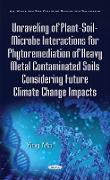- Start
- Unraveling of Plant-Soil-Microbe Interactions for Phytoremediation of Heavy Metal Contaminated Soils Considering Future Climate Change Impacts
Unraveling of Plant-Soil-Microbe Interactions for Phytoremediation of Heavy Metal Contaminated Soils Considering Future Climate Change Impacts
Angebote / Angebote:
Anthropogenic activities and pedogenesis of soils derived from ultramafic rocks have caused heavy metal contamination worldwide. During the last two decades, phytoremediation has emerged as a potential eco-friendly tool to clean up heavy metal contaminated environments. However, various climatic stresses (eg: drought, extreme temperature, etc.) can affect physiobiochemical activities of remediating plants as well as heavy metal bioavailability in soils, therefore hampering phytoremediation efficiency. This situation could be ameliorated by exploring the plant-microbe partnership, which can improve plant growth and facilitate plant metal uptake. Plants are able to bioconcentrate (phytoextraction), bioimmobilize (phytostabilization), and/or biotransform (phytovolatilization) heavy metals via in situ rhizosphere processes. The speciation, mobilization, immobilization and distribution of heavy metals in the rhizosphere where root uptake or exclusion takes place, are critical factors that affect the phytoremediation process. Moreover, the effects of climatic stresses on plant growth and metal accumulation vary substantially across physic-chemical-biological properties of the environments and plants used. Developing microbe-assisted phytoremediation for either enhancing (phytoextraction) or reducing (phytostabilization) metal bioavailability in the rhizosphere as well as improving plant establishment, growth and health could significantly speed up the process of bioremediation techniques. In this book, topics of contemporary importance are covered including plant-soil-microbe interactions at the: Molecular level (molecular signals and quorum sensing), Cellular and organismal level (establishment of associative symbiosis of plant and microbes), Biogeochemical level (heavy metal detoxification, mobilization, immobilization, transformation, transport and distribution), Ecosystem level (mechanisms involved in plant-microbe-metal interactions) and at the Technological application level (case study of using plant growth to promote rhizobacterium for phytoremediation). Additionally, climate change effects on plant-metal-microbe interactions and phytoremediation are also included. This book brings a state-of-the-art review on microbe-assisted phytoremediation resulting from plant-microbe-metal interactions, providing high quality academic knowledge and understanding of this remediation technology.
Folgt in ca. 15 Arbeitstagen

!["The Shanty boy," or, Life in a Lumber Camp: Being Pictures of the Pine Woods in Discriptions [sic], Tales, Songs and Adventures in the Lumbering Shan](https://support.digitalhusky.com/media/annotations/sorted/436/43676513/CHSBZCOP0343676513.jpg)


